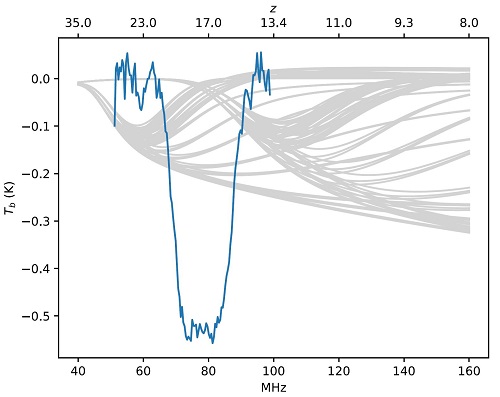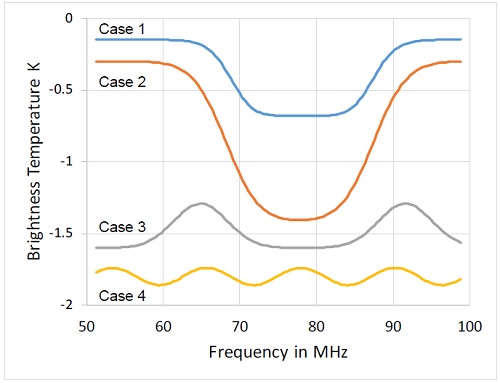Submitted by Administrator on Thu, 20/12/2018 - 16:53
A great deal of interest was created a few months ago by a paper1 announcing the detection of “An absorption profile centred at 78 megahertz in the sky-averaged spectrum”. This was a finding by the EDGES experiment showing an apparent feature in the radio emission coming from all parts of the sky which could be the signature of “Cosmic Dawn” – the moment, early in the history of the Universe, when the first stars came into being. It had previously been predicted that when the light from these first stars fell on the hydrogen gas surrounding them it would have disturbed the equilibrium between the hydrogen atoms and the surrounding radiation (the Cosmic Microwave Background). This disturbance should indeed produce an absorption feature, but the effect was expected to be much smaller than that observed. The flat-bottomed shape of the observed feature was also unexpected. The first plot shows the observed feature and the predictions for a wide range of possible ways in which things might have happened during this period, which is roughly 100 million to 300 million years after the Big Bang.

Figure 1. This shows the EDGES signal, after subtraction of foreground emission, compared with a wide range of physically plausible models derived using the ARES code2. This shows how much larger the apparent signal is than the predictions.
A large number of theoretical papers have since been published which try to explain these observations. A team based at the Kavli and the Astrophysics Group in the Cavendish Laboratory have now, however, published3 a critique of the way in which the EDGES data were analysed. This involves subtracting off the much larger “foreground” emission produced by the energetic particles in our own galaxy and in the Earth’s ionosphere. It was found that the proposed absorption profile can only be extracted from the data if the processes producing the foreground emission are assumed to have unphysical properties, for example a negative temperature for the electrons in the ionosphere, or if there is some unexplained source of errors in the measurements. It was also found that it is possible to get a good fit to the EDGES data with alternative models, which have very different properties, simply by making changes to the assumptions about the foregrounds and/or the form of the profile. The second plot shows some examples.

Figure 2. Alternative models fitted to the EDGES data. Case 1: the profile found by the EDGES team. Case 2: using the same formula for the profile but with a different model for the foreground. Case 3: using the original model for the foreground but a different formula for the profile. Case 4: with changes to both the foreground model and the profile formula. All these cases have the same number of free parameters – nine – and leave a similar level of residuals between the data and the fitted model.
The Cambridge group argues that both of these findings call into question the interpretation of the EDGES data as an unambiguous detection of the cosmological 21-cm absorption signature and that it seems premature to suppose that new physical theories are needed to explain it.
1 The EDGES results were presented by J. D. Bowman, A. E. E. Rogers, R. A. Monsalve, T. J. Mozdzen, & N. Mahesh. Nature, 555:67–70, March 2018. https://doi.org/10.1038/nature25792
2 Mirocha, J., MNRAS 443 1211M, 2014. https://doi.org/10.1093/mnras/stu1193
3 The paper “Concerns about modelling of the EDGES data” is by Richard Hills, Girish Kulkarni, P. Daniel Meerburg and Ewald Puchwein. Nature 564: E32–E34 December 2018. See https://rdcu.be/bdTZ6 (read-only access) or https://doi.org/10.1038/s41586-018-0796-5


